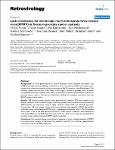Lack of evidence for xenotropic murine leukemia virus-related virus(XMRV) in German prostate cancer patients
Hohn, Oliver
Krause, Hans
Barbarotto, Pia
Niederstadt, Lars
Beimforde, Nadine
Denner, Joachim
Miller, Kurt
Kurth, Reinhard
Bannert, Norbert
Background: A novel gammaretrovirus named xenotropic murine leukemia virus-related virus (XMRV) has been recently identified and found to have a prevalence of 40% in prostate tumor samples from American patients carrying a homozygous R462Q mutation in the RNaseL gene. This mutation impairs the function of the innate antiviral type I interferon pathway and is a known susceptibility factor for prostate cancer. Here, we attempt to measure the prevalence of XMRV in prostate cancer cases in Germany and determine whether an analogous association with the R462Q polymorphism exists. Results: 589 prostate tumor samples were genotyped by real-time PCR with regard to the RNaseL mutation. DNA and RNA samples from these patients were screened for the presence of XMRV-specific gag sequences using a highly sensitive nested PCR and RT-PCR approach. Furthermore, 146 sera samples from prostate tumor patients were tested for XMRV Gag and Env antibodies using a newly developed ELISA assay. In agreement with earlier data, 12.9% (76 samples) were shown to be of the QQ genotype. However, XMRV specific sequences were detected at neither the DNA nor the RNA level. Consistent with this result, none of the sera analyzed from prostate cancer patients contained XMRV-specific antibodies. Conclusion: Our results indicate a much lower prevalence (or even complete absence) of XMRV in prostate tumor patients in Germany. One possible reason for this could be a geographically restricted incidence of XMRV infections.
Dateien zu dieser Publikation
Keine Lizenzangabe
Verwandte Publikationen
Anzeige der Publikationen mit ähnlichem Titel, Autor, Urheber und Thema.
-
2015-11-10ZeitschriftenartikelComparison of the Cowpox Virus and Vaccinia Virus Mature Virion Proteome: Analysis of the Species- and Strain-Specific Proteome Döllinger, Jörg; Schaade, Lars; Nitsche, AndreasCowpox virus (CPXV) causes most zoonotic orthopoxvirus (OPV) infections in Europe and Northern as well as Central Asia. The virus has the broadest host range of OPV and is transmitted to humans from rodents and other wild ...
-
2011-10-19ZeitschriftenartikelGrowth of influenza A virus is not impeded by simultaneous removal of the cholesterol binding and acylation sites in the M2 protein Thaa, Bastian; Tielesch, Claudia; Möller, Lars; Schmitt, Armin O.; Wolff, Thorsten; Bannert, Norbert; Herrmann, Andreas; Veit, MichaelInfluenza virus assembly and budding occur in the 'budozone', a coalesced raft domain in the plasma membrane. The viral transmembrane protein M2 is implicated in virus particle scission, the ultimate step in virus budding, ...
-
2009-07-22ZeitschriftenartikelMeasles viruses of genotype H1 evade recognition by vaccine-induced neutralizing antibodies targeting the linear haemagglutinin noose epitope Finsterbusch, Tim; Wolbert, Anne; Deitemeier, Ingrid; Meyer, Kerstin; Mosquera, Maria Mar; Mankertz, Annette; Santibanez, SabineThe linear haemagglutinin noose epitope (HNE; aa 379-410) is a protective B-cell epitope and considered to be highly conserved in both the vaccine and the wild-type measles virus (MeV) haemagglutinin (H) proteins. Vaccine ...

